PAGE 88 – August 2009
H O T I D E A S F O R S M A L L R A I L R O A D S
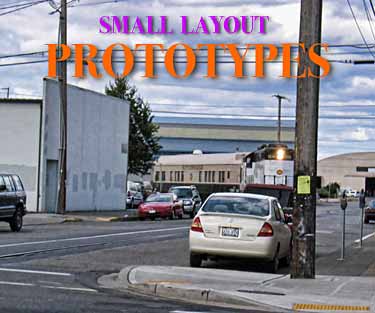
One of our most popular Scrapbook features is real-railway scenes that can be converted into excellent small or micro layouts. So here are more than a dozen delightful examples of “modelable” prototype venues from around the world!
Quarry Railroad—Massachusetts USA marble hauler
Giant Grain Elevator—Big-time agro biz in Portland OR USA
German Kids Ride—Fantasy layout at a Munich furniture store
Coal Transfer Ovals—Prototype pizzas on a big scale!
Another Prototype Oval—Calgary, Canada Heritage Park Railroad
Resort Island NG—Critter comfort on Fire Island, NY USA
Classic Brills—Restored trams/trolleys in Portugal
Sawmill Switcher—Inglenook shunting in deepest Oregon USA
Funicular Fun—Inclines in Norway and Brazil
Transylvanian Tramway—Industrial switcher in Romania
The Most Compact of All?—Erie’s 149th St. Yard in New York City
Photo by Carl Arendt
SHELF-LINE PROTOTYPE—LOCO AND ENGINE SHOP IN TACOMA USA
Montage inputs courtesy bing.com maps

All maps courtesy Google Maps
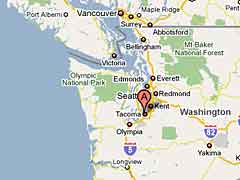
The Pacific Northwest region of the United States is a mecca for train lovers, especially the area clustered around Seattle and Puget Sound, shown in the map (left). The title photo for this page was shot in Olympia, Washington, where the Tri-City & Olympia Railroad serves the Port with street-running right through downtown! And just a few miles north via I-5 in Tacoma is the wonderful locomotive/railcar overhaul facility of the Coast Engine and Equipment Co. (CEECO).
Gordon Werner called our attention to this large and busy facility, which you can explore for yourself with Google Maps (screen shot below). Clearly visible are the arrangements of CEECO’s three-track locomotive repair shop (with six each looomotive spots inside that large building), as well as the company’s four 450ft car repair tracks with jacking pads and utility stations. Even a small portion of this facility would make an active and fascinating micro layout. And what a great place to show off your favorite diesel locomotive models!
[Ed. note: Thanks to Harald Hohendorf, who lives in Tacoma, and other readers who let me know that CEECO has gone out of business due to the current recession. Sadly, 31 July 2009 was their last day of operation. According to the local paper, their last job was rebuilding two three-foot-gauge locomotives—the famous green and yellow diesels of the White Pass & Yukon Route Railroad in Skagway, Alaska, USA. Who will be the first to help this yard live on in miniature?]

QUARRY SETTING MAKES A SCENIC MODEL DOMAIN


Quarry railroads are fun to model, particularly those of the northeastern U.S. This one, in Westford, Masssachusetts, was drawn to our attention by “Dave,” who lives in California and is the webmaster of an EJ&E Ry website. This quarry road, which features a GE 44-tonner loco (lower right), belongs to the Fletcher Granite Co. who have a photo tour on their site. This quarry produces marble, and the scenery features giant square blocks where previous cuts have been made. What remarkable and interesting scenery opportunities! Explore them on Bing Maps here.
GRAIN TRANSFER FACILITY IS IMPRESSIVE AND MODELGENIC
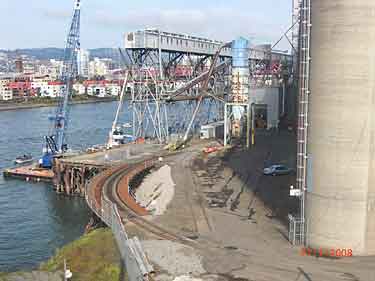
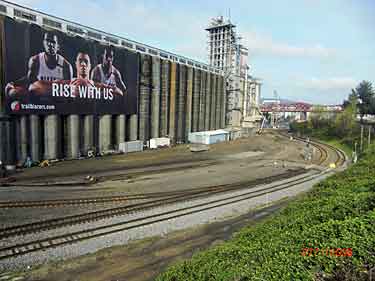

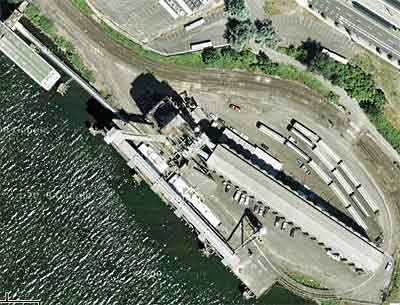
Josh Carillo, from Portland, Oregon USA, sent us links to two views (here and here) of this large and imposing grain elevator in central Portland. It’s CLD Pacific Grain’s Irving Elevator, which uses a Trackmobile to shunt the grain cars around. Josh risked life and limb on the freeways to capture the pictures that accompany this article! He deserves kudos for providing us all an inspiring prototype for an intense and detailed micro layout.
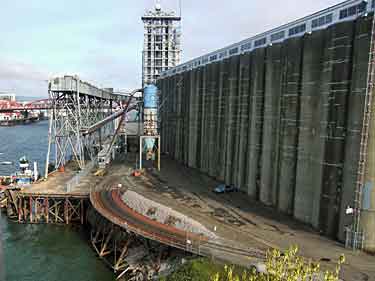
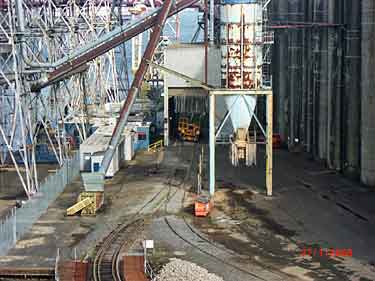
GERMAN STORE FEATURES OVAL FANTASY RAILWAY
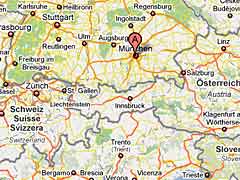
Möbel Höffner, a new furniture store in Freiham, Germany, a suburb of München (Munich) features a narrow-gauge “fantasy railway” for customers to ride. Sven Wesenberg, from nearby Gröbenzell, sent us these photos with a comment that it’s “a kind of large scale micro layout in front of the store for the kids to ride. It’s a ‘squeezed’ oval with an overall length of 23 meters, and the radius of the curves is about 5 meters. The gauge is 420mm. The 2-2-2 locomotive is a dummy, but the two cars are powered on one axle each.” Note that 16.5mm track (HO/OO standard gauge) can be used to model 420mm gauge prototypes… in 1:25 proportion. This is a prototype scene for Gn15 scale!
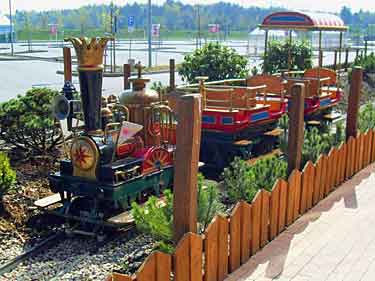
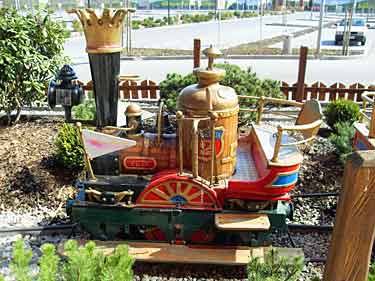
MODERN COAL TRANSFER FACILITIES MAKE PROTOTYPE OVAL LAYOUTS
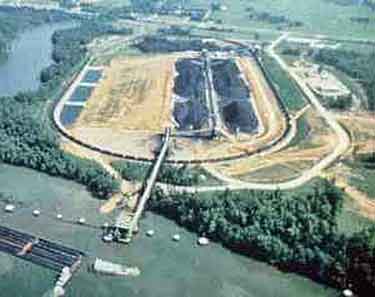
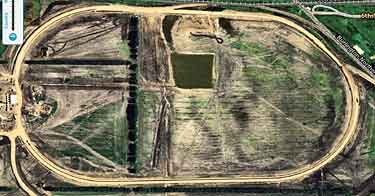
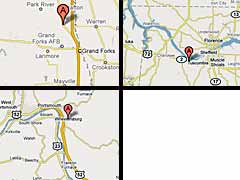
Modern railroad coal-transfer facilities tend to have track plans that look like prototype pizza layouts! Here are three examples we’ve seen recently. At the upper left is the M-Bar-D Coal Distribution Site in Ardoch, North Dakota USA, at a junction of the BNSF and Soo Line. It was called to our attention by Thamas Van Hare, from Ashburn, Virginia USA.
Thomas describes the facility this way. “Trains of 125+ coal cars enter the circuit from one of two directions at the top or right of the [Mapquest] aerial photo. Once on the loop, the locomotives pull the cars one time around, counter-clockwise, to bring the entire consist off from the mainline and into the loop, stopping just past the coal loader (at the left). The locomotives uncouple and move counter-clockwise up to the opposite end of the train where, after recoupling, they pull the train forward, now heading clockwise, back to the loader.
“The train then moves slowly forward at a set speed through the loader facility, where each car is individually and automatically weighed empty then filled with precisely the exact quantity of coal to reach maximum weight allowed. This operation is done by hand by an operator with reference to a weighing scale at the load point. The loading process is done one car at a time until all coal cars are filled to capacity. Throughout the filling process, the engines creep forward running clockwise around the loop until the last coal car is filled. Thereafter, the engines continue clockwise and exit in the opposite direction from which they entered the facility.
“Overall, this is a very clever way of filling extensive consists with coal, without having to leave cars on the mainline or have a lengthy piece of real estate for a ladder/loading yard.” [Ed. note: I can see a picture-frame pizza layout, entirely filled with a coal car train, endlessly shuffling past the spectator, emulating this operation where the train never stops but moves steadily past the loader!]
Two other similar facilities involve rail/barge connections at waterside. At the upper right is the ORBA Corporation barge to rail coal transfer facility in Pride, Alabama USA, on the Tennessee River. You can see a very long train being loaded on the loop. A Google image of this one is here.
And to complete the hat trick, Damin Keenan sent us photos of this triple-tracked Norfolk Southern rail-to-barge coal transfer facility in Wheelersburg, Ohio USA (below). Photo is courtesy of the site engineers, the APX Consulting Group. You can view the site on Google here.
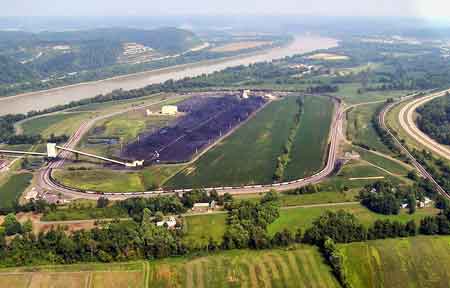
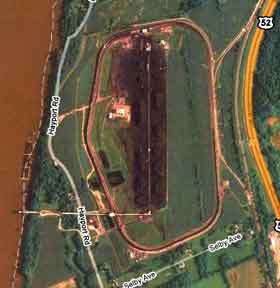
RAILROAD MUSEUM ALSO MAKES PROTOTYPE OVAL LAYOUT
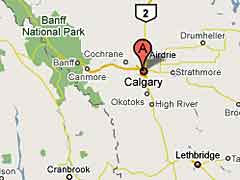
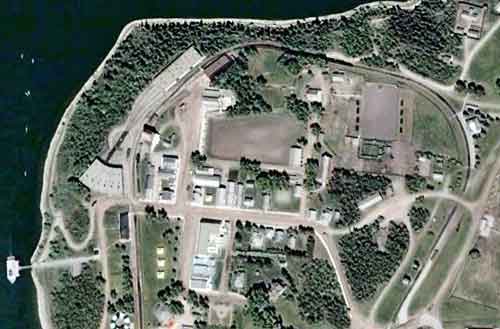
Continuing the thoughts of prototype pizza layouts, Helmut Werneburg, from Victoria, British Columbia, Canada, sent us this Google image of the standard gauge tourist layout in the Heritage Park at Calgary, Alberta, Canada. The main line completes the circuit below the cropped portion of the photo. Helmut remarked, “Years ago I actually worked here as contractor trying to maintain an ancient electric street railway car that the park used to ferry customers from the public parking lot to the park entrance. The railway train is well used during the tourist season, and the layout contains a lot that could be modeled—roundhouse, turntable, workshops and even a turning Y (wye) at top right. To the east (right) of the turntable are a couple of sidings serving a grain elevator and other small industries.” Another excellent modelgenic prototype!
SHORT NARROW-GAUGE LINE SERVES ISLAND COMMUNITY
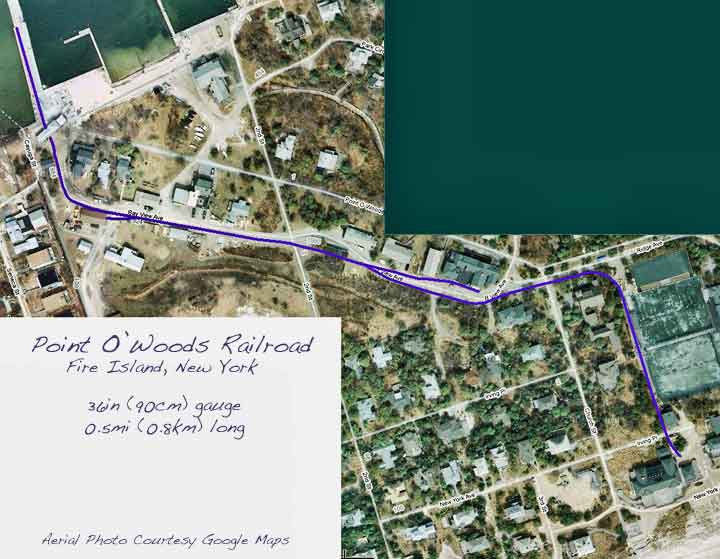
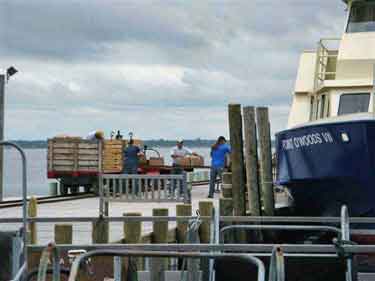
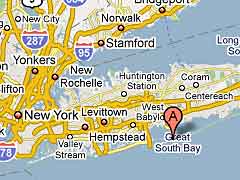
Fire Island is a long, narrow sand island in the Atlantic Ocean just south of Long Island, New York, USA. It’s a resort community with no private automobiles permitted. Its oldest settlement is Point O’Woods, a private community of 128 houses that has its own ferry boat to bring supplies in from the mainland, and its own half-mile-long, three-foot-gauge (91cm) railroad to distribute them.
We’ve received a number of photos of this delightful little railway, whose route is shown at the top of the article. It goes from the dock where they unload supplies, food for the grocery store, building materials and the like from the ferry. The railway has a stop at the materials building (behind the Fire Department) where the lumber and other building materials are stored.
A left turnout to a dead-end spur puts it behind the grocery store and the town Hall/office. Then it makes a 90-degree turn to the right (south) past the tennis courts to the Community Center. The only other stop is a little spur into the shed where the critter/locomotive and railcars are stored for the winter, located just south of the dock. This self-contained “short line” makes a prefect prototype for a sand-strewn, atmospheric model of a summer resort at its best, with a railway to make it complete!
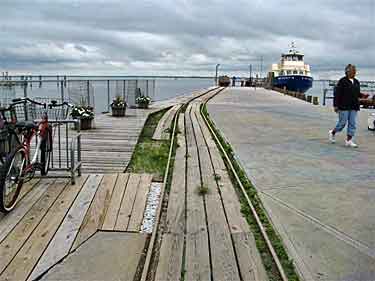
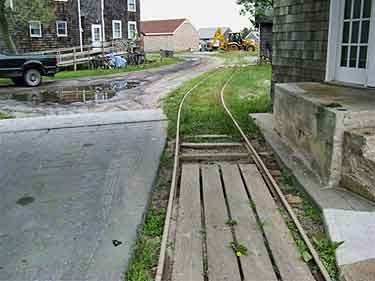
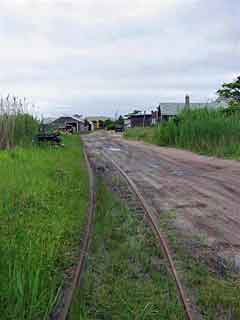
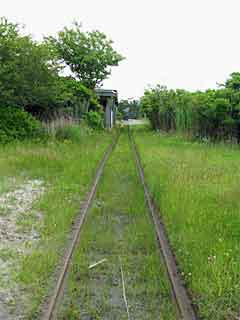
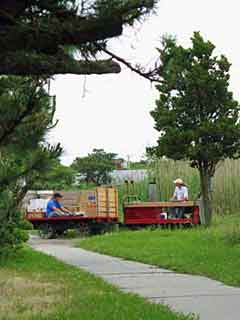
LISBON AREA TRAM SHOWS OFF ANTIQUE BRILL CARS
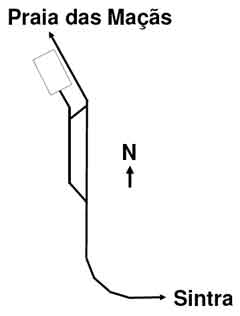
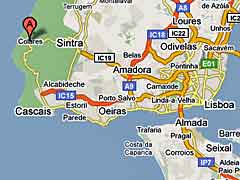
Henning Stelter, a German who currently lives and works in Portugal, sent pictures of a picturesque tram/trolley line just west of Lisbon, in Colares. Henning explains, “The tracks in Colares are surrounded by cooperative wineries. And the car barn contains a rusting tram. Colares is known for its vineyards and Cabo da Roca, the westernmost point of continental Europe.
“The 14km (8.7mi) tram route leads from Praia das Maçãs (“Beach of Apples”) on the Atlantic Ocean, passsing through Colares, to the town centre of historic Sintra on the western outskirts of Lisbon. The restored trams are still operating on week ends.” Many of the restored trams were built in the United States by Brill Co. in Philadelphia early in the Twentieth Century. A four-wheeled closed car and an open car are shown (below right) at Sintra station. The line in and around Colares (below) makes a delightful rural tram scene, ideal for a micro layout presentation.
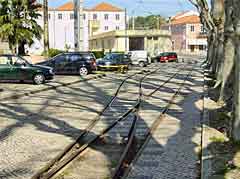
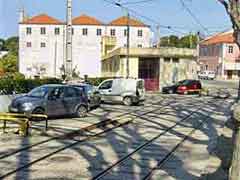
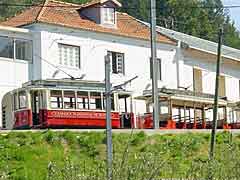
SEE AN RC TRAIN SHUNTING AT A RUSTIC SAWMILL IN OREGON
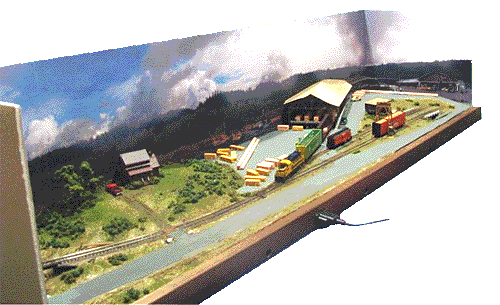
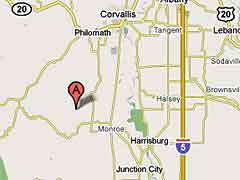
A number of modeling forums recently have been entertained by a four-part video by Ken Olsen documenting the shunting on a true Inglenook track arrangement of a steam-driven sawmill in rural Oregon. Further, the locomotive driver controls the action remotely while standing beside the track, walking along with the train and throwing the switches (points) himself! Ken built an N-scale model of the site (above left) and made a documentary of the last days of rail service. The mill is easy to find in Google Maps, at Alpine, Oregon USA. I doubt that any modeler needs more encouragement from me to think of layouts making use of this marvelous prototype! Click on the triangle below to see part one of Ken Olsen’s documentary… the other three parts are easy to find in the YouTube listings at the end.
PAIR OF FUNICULARS MAKE GREAT WORKING DISPLAY MODELS
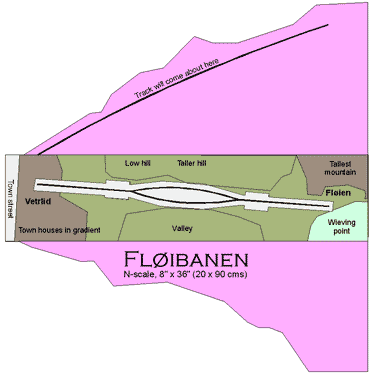
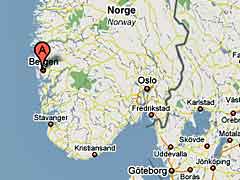
Funiculars (inclined railways) are found in many parts of the world, and can make fascinating models, popular at exhibitions. One example, currently being constructed by Jon Songøygard, from Arendal, Norway, and his son is the Fløibanen in Bergen, which climbs the mountain behind the city and offers breathtaking views of the city and harbor. The drawing at right shows Jon’s plan, along with the profile boards for the two sides of the layout, indicating the steep incline and the shape of the land. Jon plans to use the Brawa model of the Stuttgart funicular, which is amazingly similar to the Fløibanen cars up to 1947. We’ll keep you posted on the progress of this model.
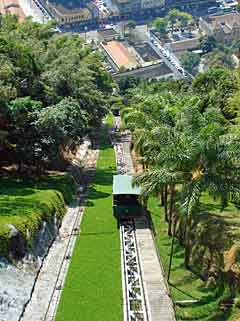
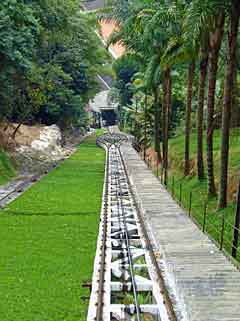
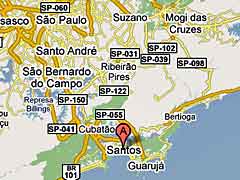
Wilson Lussari sent even less information about the cable funicular at Santos, Brazil, near São Paulo. Instead, he let his photos do the talking. Looks great! ‘Nuff said! [Ed. note: the U.S. Model Railroader magazine ran a Linn Westcott article about modeling funiculars in April 1976.]
ROMANIAN COURTYARD TRAM CAN INSPIRE MICRO DISPLAYS
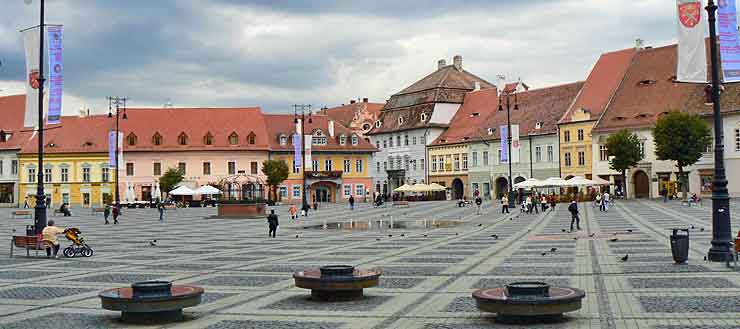
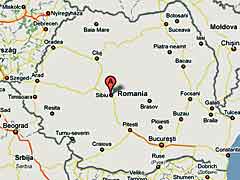
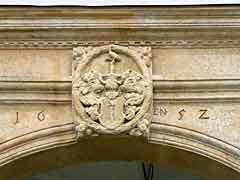
Colin Shaw, a Briton who lives in Bod, Romania, and operates an adventure travel service there, recently discovered a delightful little 600mm (2ft) narrow-gauge tramway in a most unlikely place—the medieval Piata Mare (“Big Square/Market”) (above) of Sibiu, a Saxon Transylvanian town in central Romania! Colin explains, “[The tramway was] in the courtyard of an old building in the centre of the town. All that was visible were the two rails set into concrete, running from the arched front gate under the heraldic emblem (above) with the date 1652, through a double ‘S’ bend, into the back of the courtyard… The original building is being converted into a modern city centre hotel, which sadly means destroying most of the building and its railway.”
Colin’s photos below show the arched front entrance gate and the view of the second bend from the back of the building, looking toward the front. Colin is thinking of building a Gn15 version of this little tramway (below right), which he feels ” offers surprisingly interesting operation for such a simple design. It would work with one or perhaps two small locos… Using my initials (CDS) as a basis, I have chosen the name for my imaginary furniture factory: Comode si Dulapuri Sibiu (“Sideboards and Cupboards of Sibiu”). Half of the trackwork is in open air within the courtyard… The other half of the trackwork is within the furniture factory building (A on my plan).
“Operation works as follows: raw materials arrive off the tramway at the front gate at C. They are taken into the factory at B, but the loco may need to run around them before pushing them into the factory. Wagons with finished products are stored in the siding at D, but again the loco might need to run round them first. Later they are taken from D to the collection point at C. I’m sure this track plan would work in other small industrial settings, and no doubt your readers and contributors will be able to adapt and improve my design!” (Sounds like an invitation! —Ed.)
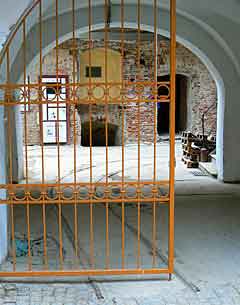
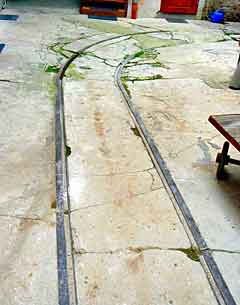
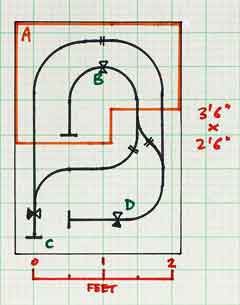
A DIFFERENT CAR-FERRY TERMINAL: ERIE RR’S 149TH STREET STATION

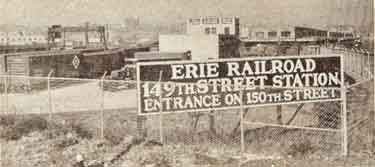
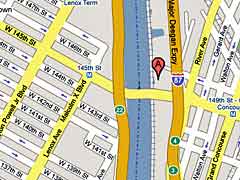
Will Ayerst, from London, England, points out another of the delightful car-ferry terminal switching yards that once served New York City’s freight-handling needs in spaces about as compact as have ever been designed. Will researched the Erie Railroad’s 149th Street Yard, nestled beside the 145th Street bridge from the Bronx to Harlem. Unlike the nearby and more famous Bronx Terminal of the Central New Jersey RR, the Erie yard, as Will says in his blog, “doesn’t have a circular freight house with trackage running around it, instead forming a fish-hook of sorts in a squashed rectangle” (see plan below).
The terminal received loads via car float, and the yard had a total capacity of 55 cars despite its miniscule size. Will’s N scale model plan, which virtually reproduces the original trackage with only a few exceptions, has a 47 car capacity and can be operated almost exactly like the prototype yard. For extensive information about the 149th Street Station and its operations, there’s an excellent web page, Harlem Station. This site includes the rare panoramic photo (above) of the yard from the 1957 Fairchild Aerial Survey in the New York State Library Digital Archives.
Will’s nearly exact N-scale reproduction fits in a 44x30in (112x76cm) space. It was, of course, irresistible to try and fit a “selectively compressed” HO version in the same space. My attempt is shown below at right. It uses Fleischmann’s 10-inch radius sectional track and 16-inch (415mm) radius turnouts. It would require slow speeds and a 40 foot maximum car size, but it can be switched much like the real thing (with much smaller capacity). A 4x6ft (120x180cm) version would come close to duplicating the original! Locos used by the Erie ranged, over the years, from classic boxcab diesels to GE 44-tonners, and finally to Alco S1 switchers.
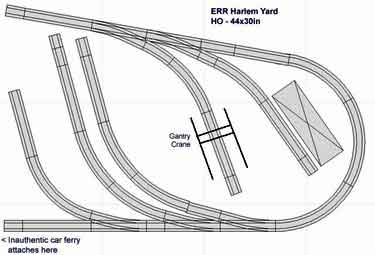
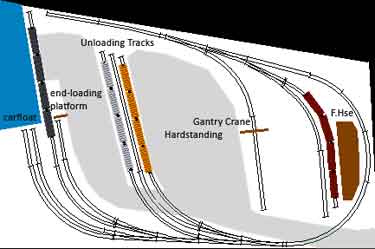
Leave a Reply